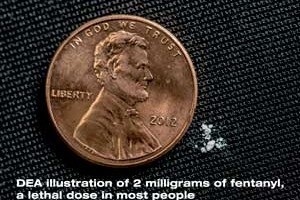
01 Jun Finding Fentanyl
Synthetic opioids, including fentanyl, buprenorphine, meperidine, methadone and others,1 comprise a class of drugs manufactured in laboratories designed to have a chemical structure similar to naturally occurring opioids, like morphine and codeine.2 Pharmaceutical fentanyl is designed to be 50-100 times more potent than morphine and is a Schedule II substance with potential for misuse and may lead to psychological or physical dependence.3 Prescription fentanyl is prescribed for use during procedures and for the treatment of severe pain, and is marketed as Abstral® Actiq®, Duragesic®, Fentora®, Lazanda®, Innovar®, Ionsys®, Lazanda®, Onsolis®, Sublimaze® and Subsys® in several forms including IV, IM, transdermal, and buccal.4
Comparatively, illicitly manufactured fentanyl (IMF) is sold through illegal drug markets but shares the same chemical structure as pharmaceutical fentanyl.5 IMF is often found pressed into counterfeit pills made to look like prescription drugs or cut into cocaine, heroin, methamphetamine, MDMA6,7,8 with or without the user’s knowledge. According to the DEA’s Drug and Chemical Evaluation Section, fentanyl is also sold illegally as a powder, dropped onto blotter paper, and put in eye droppers and nasal sprays.9 Common names for IMF include Dance Fever, Friend, Goodfellas, Jackpot, Murder 8, and Tango and Cash.10
Fentanyl analogs are synthetic opioids that are synthesized by performing chemical structure modifications of fentanyl.11 Fentanyl analogs vary in potency, with some more potent than fentanyl and others with potency similar to or less than fentanyl.12,13 Most chemical modifications made to create fentanyl analogs are used to create an illicit market, although they are less prevalent than IMF.11
While this was not the case initially, most IMF and fentanyl analogs circulating in the US today are synthesized in clandestine labs located in Mexico and are also smuggled into other countries, causing a major public health threat.8 Law enforcement, government agencies, clinical chemists, pharmacists, and physicians must all be involved in monitoring and reporting cases to decelerate the epidemic.7 From 2013 to 2017, the number of opioid-involved overdose deaths in the United States increased 90%, from 25,052 to 47,600. This increase was primarily driven by an increase in deaths involving IMF or fentanyl analogs mixed with heroin, sold as heroin, or pressed into counterfeit prescription pills. IMF was involved in approximately two-thirds of opioid deaths from January to June 2018. As IMF use is increasing, prescription opioids and non-IMF use is decreasing. Specifically, prescription opioid overdose deaths peaked in 2017 and continues to decline, and deaths involving non-IMF, fentanyl analogs, and other illicit synthetic opioids decreased from January to June 2018. Overall, from 2013 onward, use or exposure to IMF is driving the occurrence of overdose deaths15,16,17,18 Both images below represent potentially lethal doses of fentanyl if ingested by an opioid-naive adult. The image on the right also demonstrates equivalent potency for a dose of heroin compared to a dose of fentanyl.19,20
The CDC provides guidance for clinicians to collaborate with public health agencies in the fight against the opioid epidemic. The CDC states that “the addition of fentanyl testing in routine clinical toxicology tests allows for early warnings of supply contamination and provides one of the best sources of routine surveillance for fentanyl in the local drug supply. The results of fentanyl screens may also have implications for the clinical management of substance use disorder for fentanyl-exposed individuals and for public health responses to opioid use and overdose.”21 Most point of care (POC) testing, also known as immunoassays, detect a compound based on cross-reactivity and may not detect the nor-metabolites of fentanyl consistently.22 Studies have shown that false negatives using POC opioid testing can occur up to 39% of the time, and false positives of opioids can occur up to 34% of the time.23,24,25,26Comparatively, definitive testing detects compounds based on chemical composition and mass, compound separation, and uniquely identifies a drug or metabolite. Aegis utilizes a definitive test using liquid chromatography and tandem mass spectrometry (LC/MS/MS), which minimizes false negative and false positives from other medications and yields a positive result for both fentanyl and the nor-metabolite of fentanyl.27,28
When fentanyl is positive on a urine or oral fluid drug test, it is recommended to rule out both prescription sources and recent procedurally administered fentanyl before considering illicit sources, since these could be opportunities for legitimate use. Patients that have had a procedure, ER visit, or hospitalization just prior to collection where fentanyl was administered may have detectable levels of the drug in urine or oral fluid specimens. This type of administration would not necessarily show up in a state prescription monitoring program, but it could be verified through reviewing medical records related to the procedure or visit. As stated above, IMF and pharmaceutical fentanyl share the same chemical structure, so they may both contribute to positive results for fentanyl when tested using a definitive method. Additionally, both fentanyl and norfentanyl are thought to be potential metabolites of several fentanyl analogs. The typical estimated period of detection for fentanyl is up to 5 days in urine and up to 48 hours in oral fluid; however, an extended detection of fentanyl due to its lipophilic nature is possible. 22 In a study by Hun et al, the mean clearance time for fentanyl was 7 days and for norfentanyl was 13 days. The longest period of detection in this study was for one patient who tested positive for fentanyl for 19 days, and norfentanyl for 26 days after last use.29 If a patient continues to be positive beyond the standard period of detection, re-use or the lipophilic nature of the drug, although rare, may be influencing factors. Including NPS (novel psychoactive substances) and fentanyl in drug monitoring tests when medically necessary may reduce IMF and polysubstance use related deaths.15The following fentanyl analogs are included in Aegis’ testing menu:
|
2-Furanyl Fentanyl |
Cyclopropyl Fentanyl |
|
2-Furanylbenzyl Fentanyl |
Despropionyl Fluorofentanyl |
|
Acryl Fentanyl |
FluoroFentanyl |
|
Benzoyl Fentanyl |
Fluorofuranyl Fentanyl |
|
Benzyl Fentanyl |
Fluoroisobutyryl Fentanyl |
|
Bromofentanyl |
Methyl Fentanyl |
|
Butyryl Fentanyl |
Norcarfentanil |
|
Chlorofentanyl |
Valeryl Fentanyl |
NOTICE: The information above is intended as a resource for health care providers. Providers should use their independent medical judgment based on the clinical needs of the patient when making determinations of who to test, what medications to test, testing frequency, and the type of testing to conduct.
Aegis currently offers the most extensive and continually updated testing of NPS. See https://www.aegislabs.com/the-aegis-difference/differentiators/novel-psychoactive-substances/ for a comprehensive and up-to-date list. Identifying patients who are willing to take unknown risks through the use of NPS may save lives.
References:
1. Depriest A, Heltsley R, Black DL, Cawthon B, Robert T, Moser F, Caplan YH, Cone EJ. Urine drug testing of chronic pain patients. III. Normetabolites as biomarkers of synthetic opioid use. J Anal Toxicol. 2010 Oct;34(8):444-9. doi: 10.1093/jat/34.8.444. PMID: 21819788.
2. https://www.addictioncenter.com/opiates/synthetic-opioids/
3. https://www.deadiversion.usdoj.gov/schedules/
4. https://www.accessdata.fda.gov/scripts/cder/daf/
5. https://www.cdc.gov/drugoverdose/opioids/fentanyl.html
6. https://www.drugabuse.gov/publications/drugfacts/fentanyl
7. Armenian, P., et al., Fentanyl, fentanyl analogs and novel synthetic opioids: A comprehensive review, Neuropharmacology (2017), https://doi.org/10.1016/j.neuropharm.2017.10.016
8. https://www.dea.gov/factsheets/fentanyl
9. Drug and Chemical Evaluation Section, Office of Diversion Control, Drug Enforcement Administration
10. https://www.drugabuse.gov/drug-topics/fentanyl
11. Vardanyan, Ruben S, and Victor J Hruby. “Fentanyl-related compounds and derivatives: current status and future prospects for pharmaceutical applications.” Future medicinal chemistry vol. 6,4 (2014): 385-412. doi:10.4155/fmc.13.215
12. https://www.cdc.gov/drugoverdose/opioids/fentanyl.html;
13. https://www.deadiversion.usdoj.gov/drug_chem_info/frs.pdf.
14. https://cesar.umd.edu/sites/cesar.umd.edu/files/pubs/DEA-Emerging-Threat-Report-2020-Annual.pdf
15. Gladden RM, O’Donnell J, Mattson CL, Seth P. Changes in Opioid-Involved Overdose Deaths by Opioid Type and Presence of Benzodiazepines, Cocaine, and Methamphetamine – 25 States, July-December 2017 to January-June 2018 MMWR Morb Mortal Wkly 16. Rep. 2019 Aug 30;68(34):737-744. doi: 10.15585/mmwr.mm6834a2. PMID: 31465320; PMCID: PMC6715260.
17. Zoorob M. Fentanyl shock: The changing geography of overdose in the United States. Int J Drug Policy 2019;70:40–6. https://doi. org/10.1016/j.drugpo.2019.04.010
18. US Department of Justice, Drug Enforcement Administration. 2018 national drug threat assessment. Washington, DC: US Department of Justice, Drug Enforcement Administration; 2018. https://www.dea.gov/sites/default/files/2018-11/DIR-032-18%202018%20NDTA%20 %5Bfinal%5D%20low%20resolution11-20.pdf
Ciccarone D. The triple wave epidemic: Supply and demand drivers of the US opioid overdose crisis. Int J Drug Policy 2019;S0955-3959(19)30018 https://doi.org/10.1016/j.drugpo.2019.01.010
19. https://cco.ndu.edu/Media/Images/igphoto/2002090915/
20. https://www.statnews.com/2016/09/29/why-fentanyl-is-deadlier-than-heroin/
21. https://www.cdc.gov/drugoverdose/pdf/pubs/2018-evidence-based-strategies.pdf
22. Baselt, Disposition of Toxic Drugs and Chemicals in Man, 10th edition.
23. Manchikanti, et al. Comparative evaluation of the accuracy of immunoassay with liquid chromatography tandem mass spectrometry (LC/MS/MS) of urine drug testing (UDT) opioids and illicit drugs in chronic pain patients. Pain Physician 2011; 14(2): 175-87.
24. Kirsh KL, Heit HA, Huskey A, Strickland J, Egan K, Passik SD. Trends in drug use from urine drug testing of addiction treatment clients. J Opioid Manag. 2015 Jan-Feb;11(1):61-8. doi: 10.5055/jom.2015.0253. PMID: 25750166.
25. Snyder ML, Fantz CR, Melanson S. Immunoassay-Based Drug Tests Are Inadequately Sensitive for Medication Compliance Monitoring in Patients Treated for Chronic Pain. Pain Physician. 2017 Feb;20(2S):SE1-SE9. PMID: 28226337.
26. Johnson-Davis KL, Sadler AJ, Genzen JR. A Retrospective Analysis of Urine Drugs of Abuse Immunoassay True Positive Rates at a National Reference Laboratory. J Anal Toxicol. 2016 Mar;40(2):97-107. doi: 10.1093/jat/bkv133. Epub 2015 Dec 13. PMID: 26668238.
27. Stafford DT. Chromatography. In: Levine B, ed. Principles of Forensic Toxicology. 4th ed. Washington, D.C.: AACC Press;2013:121-48.
28. Grebe, Stefan Kg, and Ravinder J Singh. “LC-MS/MS in the Clinical Laboratory – Where to From Here?.” The Clinical biochemist. Reviews vol. 32,1 (2011): 5-31.
29. Huhn AS, Hobelmann JG, Oyler GA, Strain EC. Protracted renal clearance of fentanyl in persons with opioid use disorder. Drug Alcohol Depend. 2020;214:108147.




